This article highlights the essential ABA acronyms that every parent should know to effectively support their child's therapy. Understanding these acronyms, like RBT (Registered Behavior Technician) and FBA (Functional Behavior Assessment), can truly empower you as a parent. It helps you engage in your child's progress and collaborate with professionals. This collaboration ultimately enhances treatment outcomes and fosters independence in children with autism.
Let’s explore this together! By becoming familiar with these terms, you’re taking an important step in your child’s journey. You’re not just a bystander; you’re an active participant in their growth. Remember, every little bit of knowledge helps you advocate for your child’s needs and encourages their development.
We’re here to help you every step of the way! So, dive into these acronyms and let’s make this journey a shared experience that leads to positive change for your family.
Navigating the world of Applied Behavior Analysis (ABA) can feel a bit daunting for many parents on their child's therapy journey. Understanding key ABA acronyms isn’t just helpful; it’s crucial for effective communication with professionals and for actively participating in your child's development.
Have you ever wondered what happens when parents don’t have this knowledge? Mastering these terms can truly lead to more successful outcomes in therapy.
Let’s explore this together!
In the world of Applied Behavior Analysis (ABA), communication is often made easier through the use of ABA acronyms. For parents, getting to know these terms is crucial for understanding their child's therapy and connecting with professionals. Let’s explore some essential ABA acronyms that every parent should know, beginning with Rori Care's distinctive approach to ABA therapy, which combines technology with personalized care.
A key part of Rori Care's commitment to excellence is ensuring that all Registered Behavior Technicians (RBTs) pass the board exam. This shows their mastery of the RBT Task List. This certification process not only confirms their skills but also empowers caregivers with strategies and ABA acronyms. This way, parents can actively support their child's behavioral goals through informed involvement and data collection. We’re here to help you every step of the way!
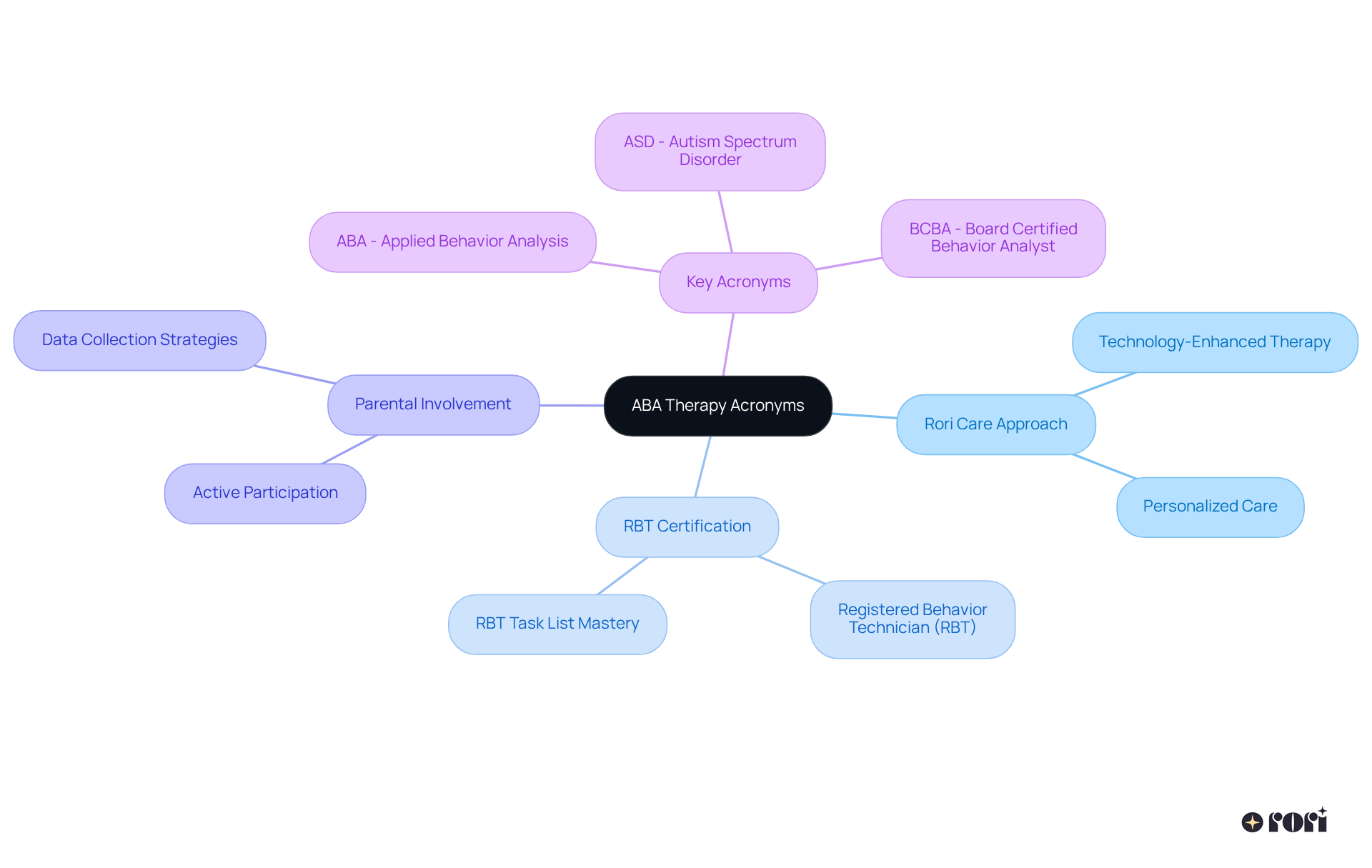
The scientific approach of Applied Behavior Analysis (ABA) is often referred to by its ABA acronyms, helping us understand actions and learning processes. It utilizes evidence-based methods to enhance important behaviors, especially communication and social skills, which are vital for children with autism, often referred to in the context of ABA acronyms. Through organized interventions, the principles outlined in ABA acronyms aim to promote positive behavior changes and support learning, ultimately improving the quality of life for these kids.
Recent studies show that ABA therapy can lead to significant improvements in communication skills. Many children involved in ABA therapy experience enhanced verbal and non-verbal abilities through tailored interventions. For instance, kids often enjoy better social interactions as the therapy emphasizes developing essential social skills like turn-taking and sharing.
The effectiveness of ABA acronyms is further emphasized by its focus on measurable outcomes, ensuring that interventions are personalized and grounded in scientific evidence. Now, let’s talk about the role of parents! Their involvement is crucial for the success of ABA therapy. When parents are actively engaged, treatment outcomes improve significantly.
Caregivers who understand ABA acronyms can make informed decisions that positively influence their child's progress, leading to better behavioral outcomes. Plus, the knowledge and skills gained through caregiver education empower them, reducing stress and enhancing family dynamics.
By integrating these evidence-based techniques, ABA therapy empowers children with autism to achieve meaningful improvements in their daily lives. This fosters independence and boosts their overall well-being. At Rori Care - ABA Therapy, we believe in the transformative power of ABA therapy and are dedicated to making it accessible, effective, and empowering for everyone. Let’s explore this together! We’re here to help you every step of the way!
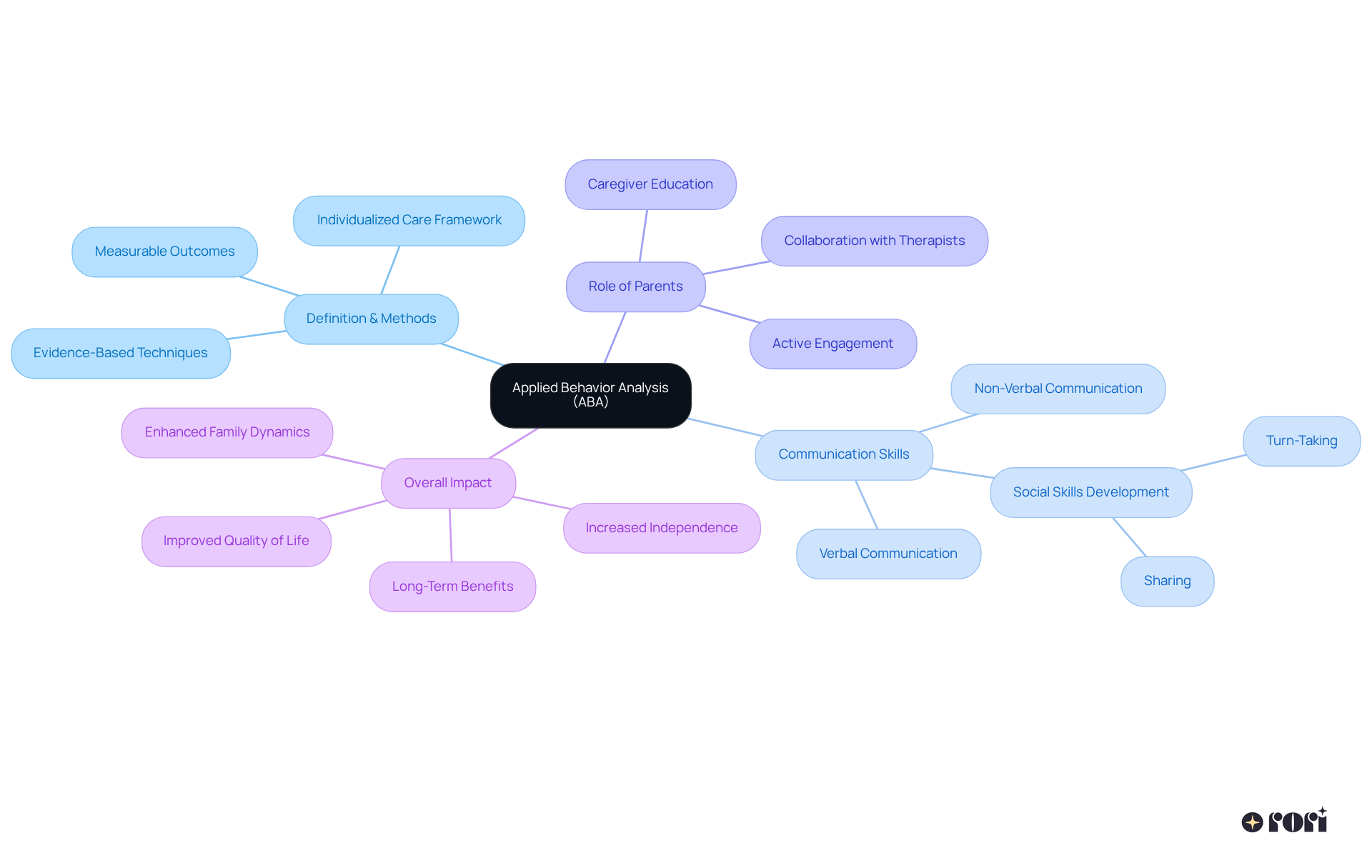
BCBA, or Board Certified Behavior Analyst, is a prestigious credential that shows an individual has successfully completed extensive educational and experiential requirements in the analysis of conduct. To qualify as a BCBA in 2025, candidates need a master's degree in behavior analysis or a related field, complete a specific number of supervised fieldwork hours, and pass the BCBA exam. This exam assesses their knowledge of ABA acronyms, as well as principles and practices.
BCBAs play a crucial role in autism therapy! They:
Their expertise is vital in ensuring that interventions are effective and tailored to meet each individual's unique needs. Studies show that BCBA-led interventions greatly enhance youth development results, promoting abilities such as communication, social interaction, and independence.
Along with direct intervention, BCBAs use advanced tools like a care engine that conducts functional analysis and produces automatic progress reports. This innovation boosts the efficiency of monitoring target behaviors and skills, ultimately freeing up 50% more time for direct treatment. The duties of BCBAs also involve continuous assessment and modification of treatment plans based on the individual's progress, ensuring flexibility and optimizing the effectiveness of ABA acronyms in therapy.
As the demand for qualified BCBAs continues to grow, their role in improving the quality of life for youngsters with autism becomes increasingly essential. Parents, let’s explore this together! Collaborating with BCBAs and seeking their expertise can truly support your child's development effectively.
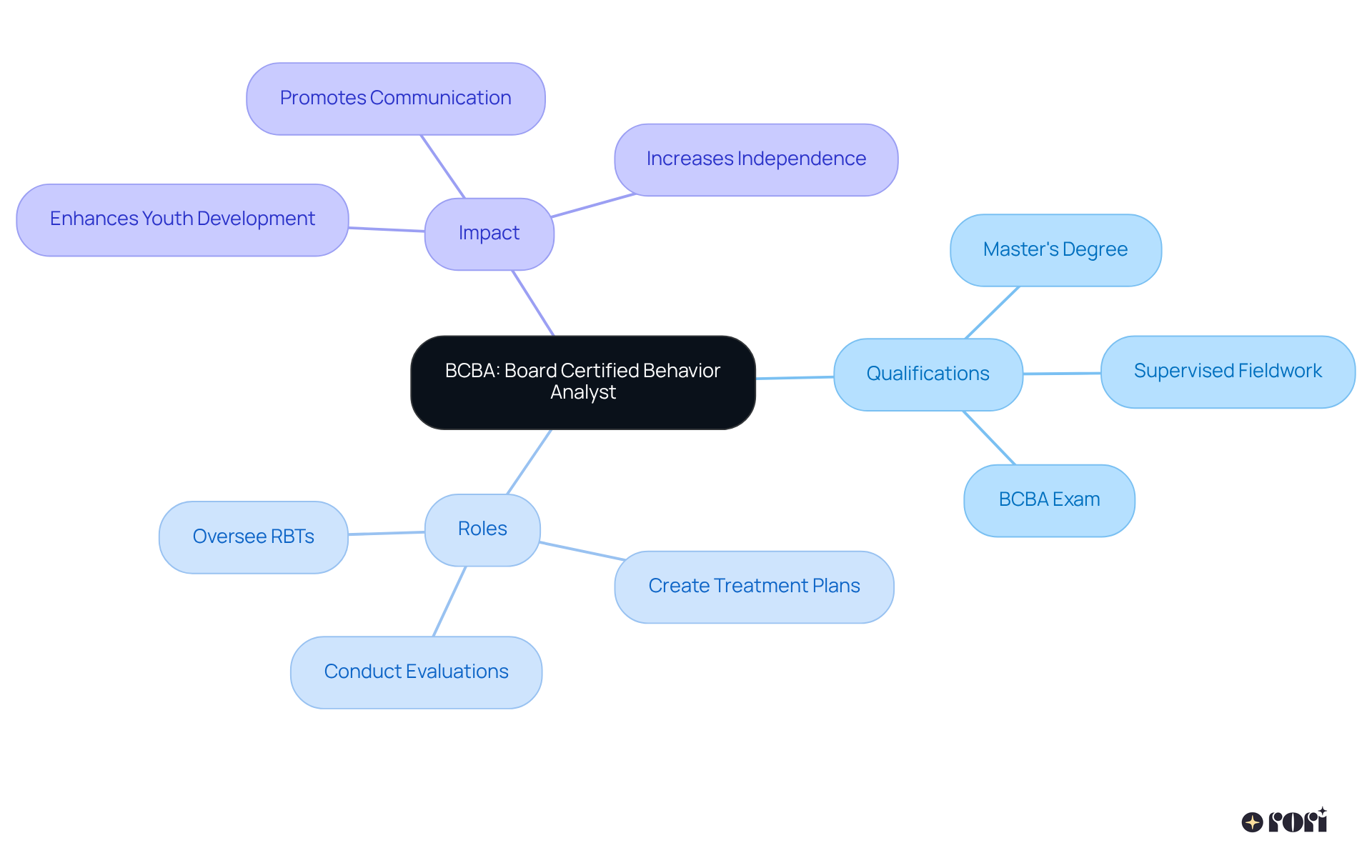
RBT stands for Registered Behavior Technician, and these amazing paraprofessionals work under the guidance of BCBAs to implement ABA acronyms in their therapy sessions. They play a vital role in empowering our youth with the skills they need to navigate the world independently. At Rori Care, RBTs deliver customized interventions, collect data on each student's progress, and provide feedback to the BCBA for any necessary adjustments.
By actively engaging in the day-to-day application of ABA strategies, RBTs help maximize the effectiveness of therapy, especially when caregivers are involved and informed about ABA acronyms and principles. This partnership is crucial for achieving substantial growth in our youth. Did you know that insurance coverage options can help with up to 100% of ABA treatment expenses?
The anticipated results of RBT participation include:
All of which contribute to the overall growth of individuals with autism spectrum disorder. Let’s explore this journey together and see how we can support our children in reaching their full potential!
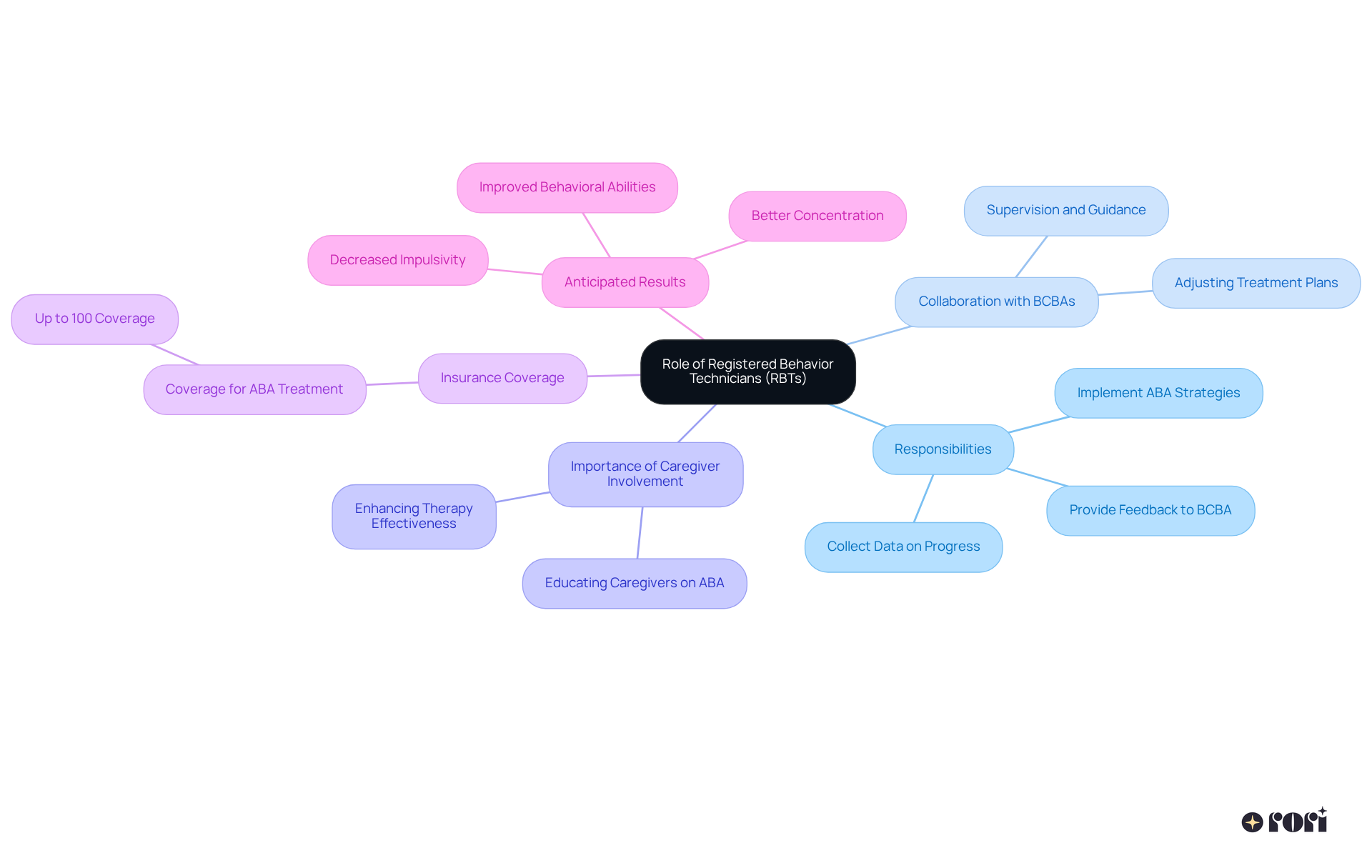
ADL, or Activities of Daily Living, includes essential abilities that help individuals carry out daily tasks on their own, like dressing, grooming, and eating. In the world of ABA therapy, understanding ABA acronyms and teaching these ADLs is super important! Not only does it encourage independence, but it also significantly boosts the overall quality of life for individuals with autism. 🌟
Studies show that when we start teaching these skills early, it can lead to big improvements in self-sufficiency. For example, over 80% of families report feeling a greater quality of life and less stress after joining early intervention programs. By breaking these tasks into manageable steps, therapists can really help kids master these essential skills.
At Rori Care, our behavior care engine continuously updates treatment plans based on progress report data. This way, every child gets personalized support tailored just for them! Success stories abound—like Ethan, who reduced his tantrums by 70% and improved his communication skills after joining an ABA-based early intervention program. This progress truly shows the transformative power of teaching ADLs!
Moreover, focusing on generalization—applying learned skills in different settings—has been linked to more sustainable and long-term success in behavioral outcomes. The emphasis on ADLs within ABA acronyms highlights the importance of providing kids with the tools they need to thrive in daily life, particularly when caregivers are actively involved in the journey. Let’s explore this together and see how we can support our little ones every step of the way!
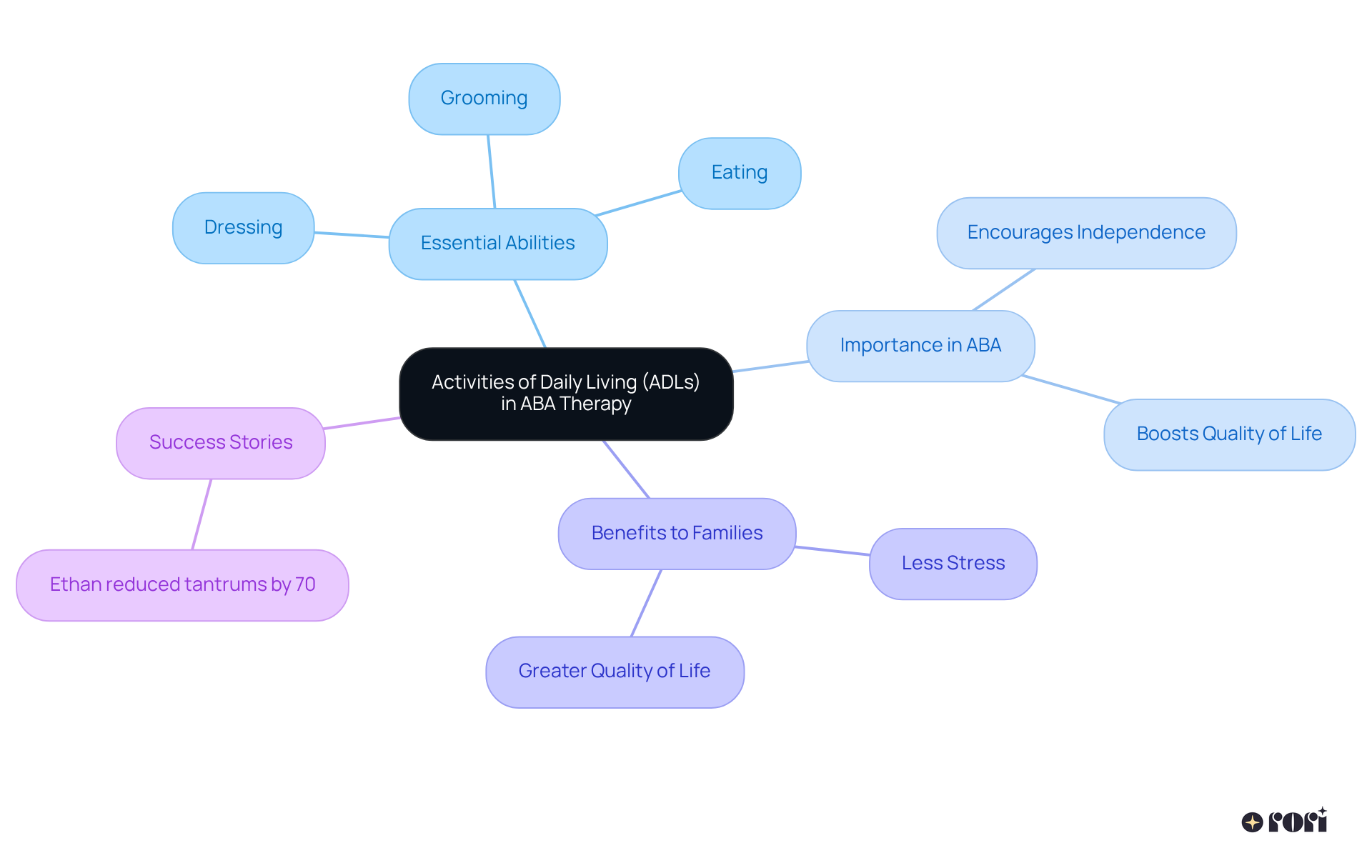
SD, or Discriminative Stimulus, is a key concept in Applied Behavior Analysis (ABA) that signals when reinforcement is available for a specific action. For example, when a child learns to say 'please' to ask for a toy, that word acts as an SD, prompting the desired behavior. Understanding this is crucial for parents, as it sheds light on how therapists use signals to teach and reinforce positive actions.
Expert insights emphasize how SDs influence behavior. As mentioned, 'Stimulus salience is the extent to which an S differs from background stimulation.' This highlights that the effectiveness of an SD depends on how distinct it is in the environment. This uniqueness helps children recognize and respond appropriately to cues, enhancing their learning experience and aligning with the strategies developed by certified practitioners.
You can see SDs in everyday life too! For instance, when the doorbell rings, it can cue a child to greet a visitor. These real-world examples show how SDs facilitate learning and engagement in preferred activities, while caregivers observe these interactions to inform future strategies.
But SDs do more than just help with recognition; they play a vital role in teaching positive behaviors. By consistently linking specific cues with reinforcement, therapists can guide children toward constructive actions. This not only encourages compliance but also nurtures social skills and independence, highlighting the importance of caregiver involvement.
Ultimately, SDs have a profound impact on behavior modification. They provide the context for when certain actions will lead to positive outcomes, reinforcing those behaviors and promoting beneficial changes. By understanding how SDs work, parents can better support their children's development, fostering a collaborative approach to behavior modification.
To make the most of this approach, caregivers should regularly collect data on their children's responses to various SDs. This practice helps monitor progress and refine strategies, ensuring interventions align with the child's evolving needs. Plus, the ABC chart in ABA therapy—Antecedent, Action, and Consequence—serves as a fundamental tool for observing and interpreting behaviors, illustrating how ABA acronyms fit into the broader framework of behavioral analysis.
Let’s explore this together! We’re here to help you every step of the way!
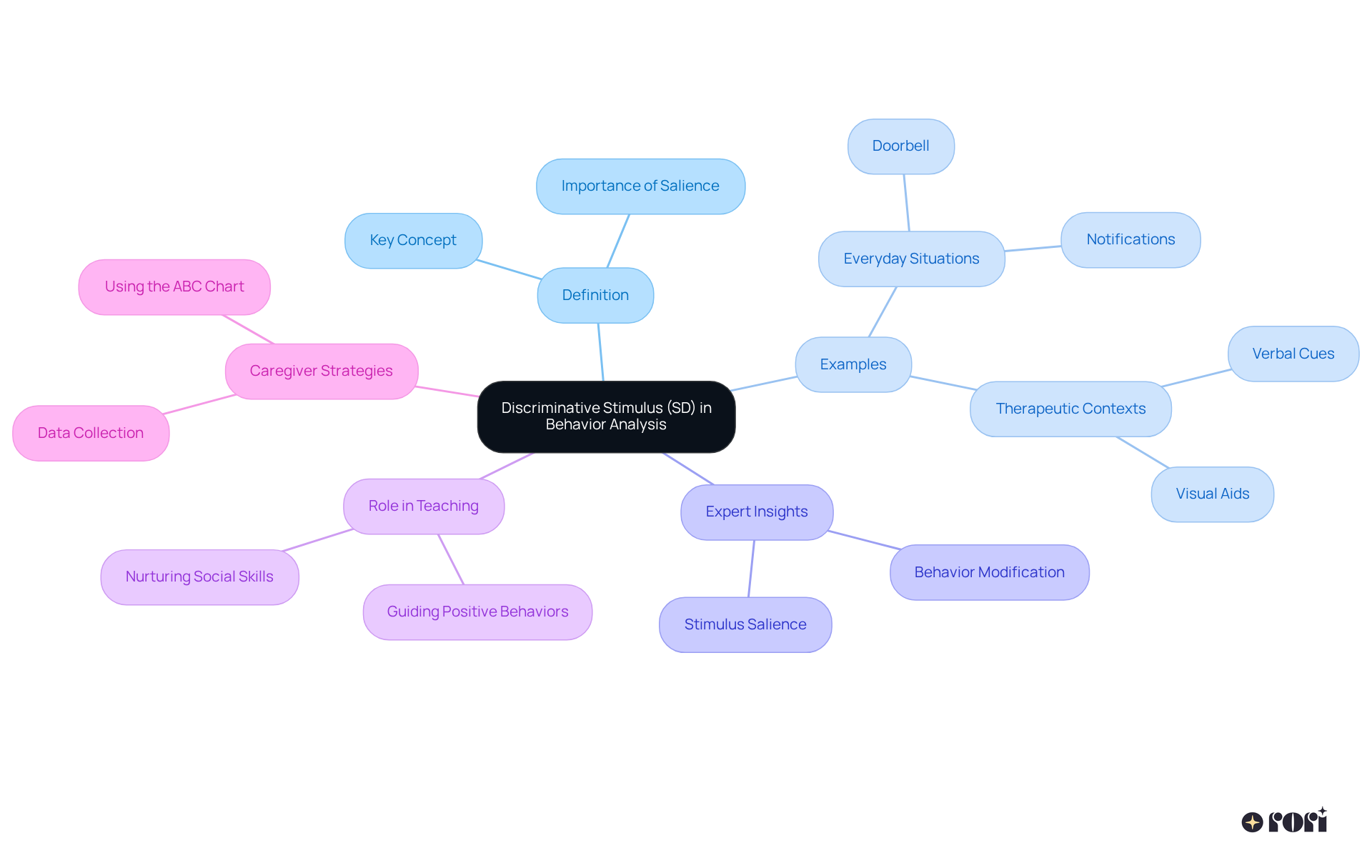
A 'mand' is a special kind of verbal behavior that acts as a request, playing a crucial role in how our little ones communicate their needs and wants. For example, when a child says 'juice' to indicate they want a drink, they’re using a mand effectively. In the world of ABA therapy, teaching mands is super important for boosting communication skills and promoting independence, as it empowers children to express their needs using ABA acronyms.
Research shows that kids who receive mand training often make great strides in their communication abilities. Studies reveal that these young learners can pick up mands for items they’re missing and engage in more spontaneous conversations. Experts highlight that training related to ABA acronyms not only reduces challenging behaviors but also encourages social interactions, making it a key part of early language education for children with autism.
There are so many success stories out there! Many children have shown remarkable progress in their communication skills through targeted mand training, which ultimately enhances their quality of life and ability to connect meaningfully with others. It’s also vital for caregivers to be part of this journey, as they can learn strategies like modeling language, using visual aids, and applying reinforcement techniques to support their child's learning.
To further boost communication skills, caregivers are encouraged to practice mand training at home. This can be done by creating opportunities for their little ones to request items or activities, reinforcing their ability to express themselves effectively. Let’s explore this together and see how we can make a difference in our children's communication journey!
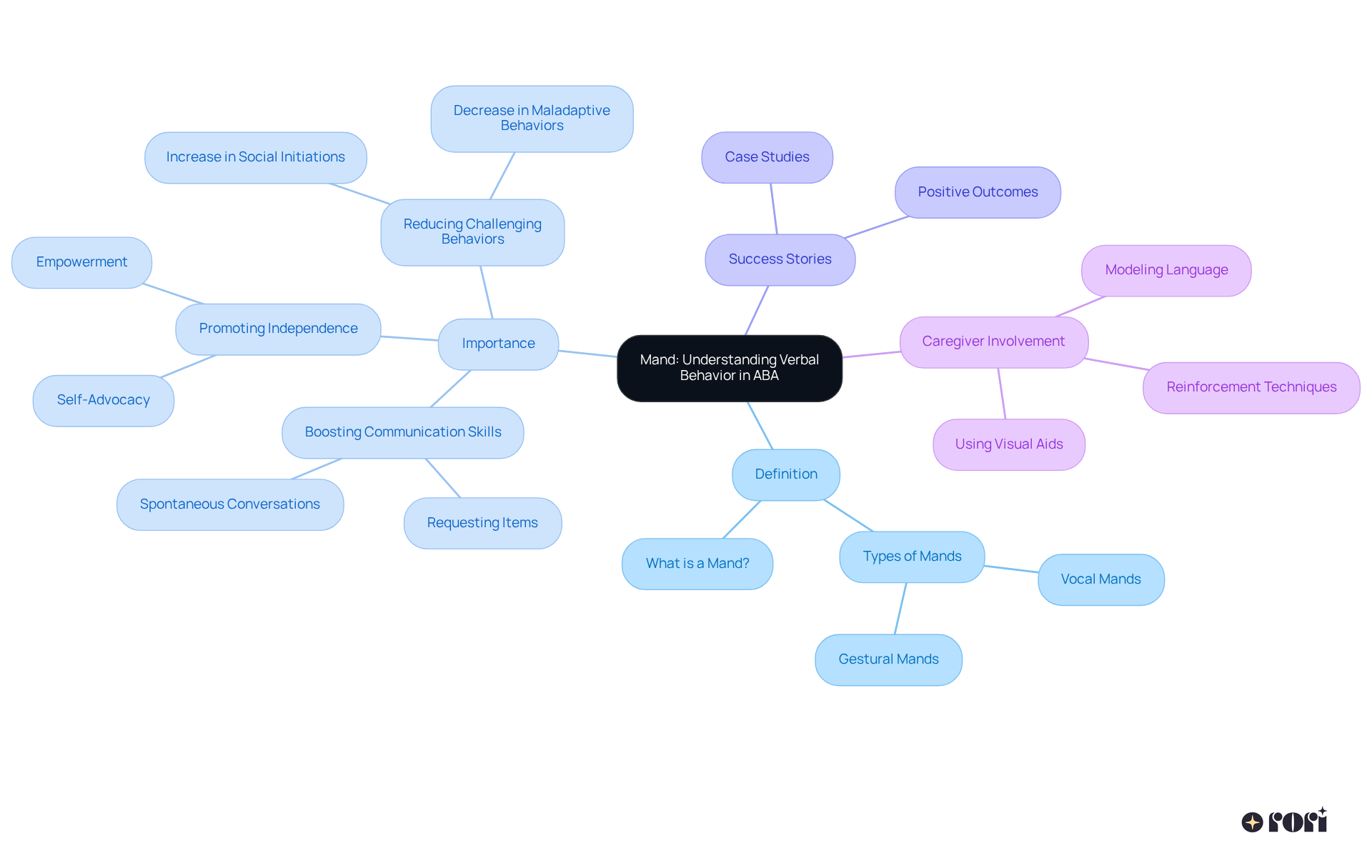
In Applied Behavior Analysis (ABA) therapy, a reinforcer is any stimulus that boosts the likelihood of an action being repeated. Reinforcers can come in many forms, like tangible rewards, verbal praise, or fun activities. For instance, when a child receives a sticker for completing a task, that sticker serves as a motivator, encouraging them to repeat those desired actions in the future.
Did you know that research shows 68.7% of children in ABA programs make significant progress? This improvement often shows up in better Vineland ABC scores when effective reinforcement strategies are in place. It really highlights how understanding different types of reinforcers—like positive reinforcement, which adds something enjoyable, and negative reinforcement, which removes something unpleasant—can help encourage positive changes in behavior.
Experts suggest that personalized reinforcement strategies, especially those that involve active parental participation, can lead to even better outcomes in behavior modification. For example, using a token economy system, where kids earn tokens for showing preferred behaviors, has proven effective in motivating children and enhancing their learning experiences. By grasping the nuances of reinforcement, parents can play a crucial role in supporting their children's growth and behavior management.
Let’s explore this together! Understanding reinforcement can truly make a difference in your child’s journey.
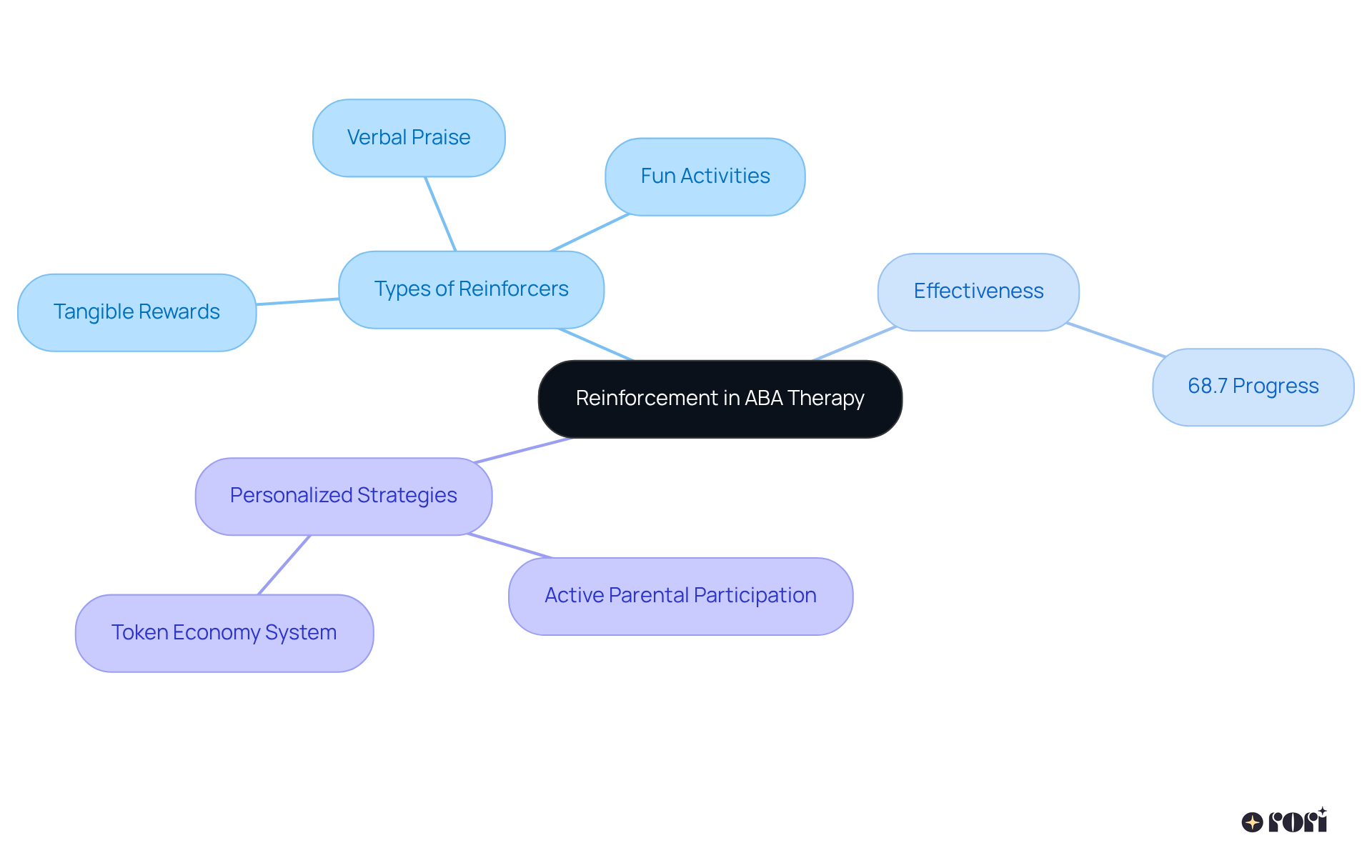
FBA, or Functional Behavior Assessment, is a systematic method designed to uncover the underlying reasons behind a young person's challenging behaviors and the environmental factors that play a role. By identifying the function of the behavior—whether it's to gain attention, escape a situation, or access a tangible item—therapists can create targeted interventions that effectively address these root causes. For example, if a young one is throwing tantrums, an assessment might reveal that this behavior is a way to escape a difficult task. This insight allows for strategies that teach the young one more appropriate ways to express their needs.
For parents, understanding FBAs and the related ABA acronyms is crucial, as it emphasizes the individualized nature of ABA therapy. Each evaluation is tailored to the unique circumstances of the child, ensuring that interventions are not only effective but also relevant to their specific challenges. Rori Care’s conduct care engine enhances this process by conducting functional analyses for target actions and skills, producing automatic progress reports for clinicians to review. Experts agree that a thorough FBA can significantly improve treatment outcomes. In fact, research shows that youngsters who undergo FBAs often experience notable decreases in problematic behaviors, as these evaluations lead to more customized and efficient treatment strategies.
Moreover, FBAs play a vital role in identifying challenging behaviors, allowing clinicians to implement interventions that are sensitive to the unique variances in each individual’s behavior control factors. This process not only fosters a deeper understanding of the young one's needs but also empowers parents to actively participate in their therapeutic journey, reinforcing the collaborative nature of effective therapy using ABA acronyms. As Nathan A Call points out, even though evidence suggests that a treatment’s effectiveness improves when based on the results of a functional analysis, several barriers still limit consumers’ access to this optimal format of FBA. This underscores the importance of ongoing advocacy and support for families navigating the FBA process. Let’s explore this together!
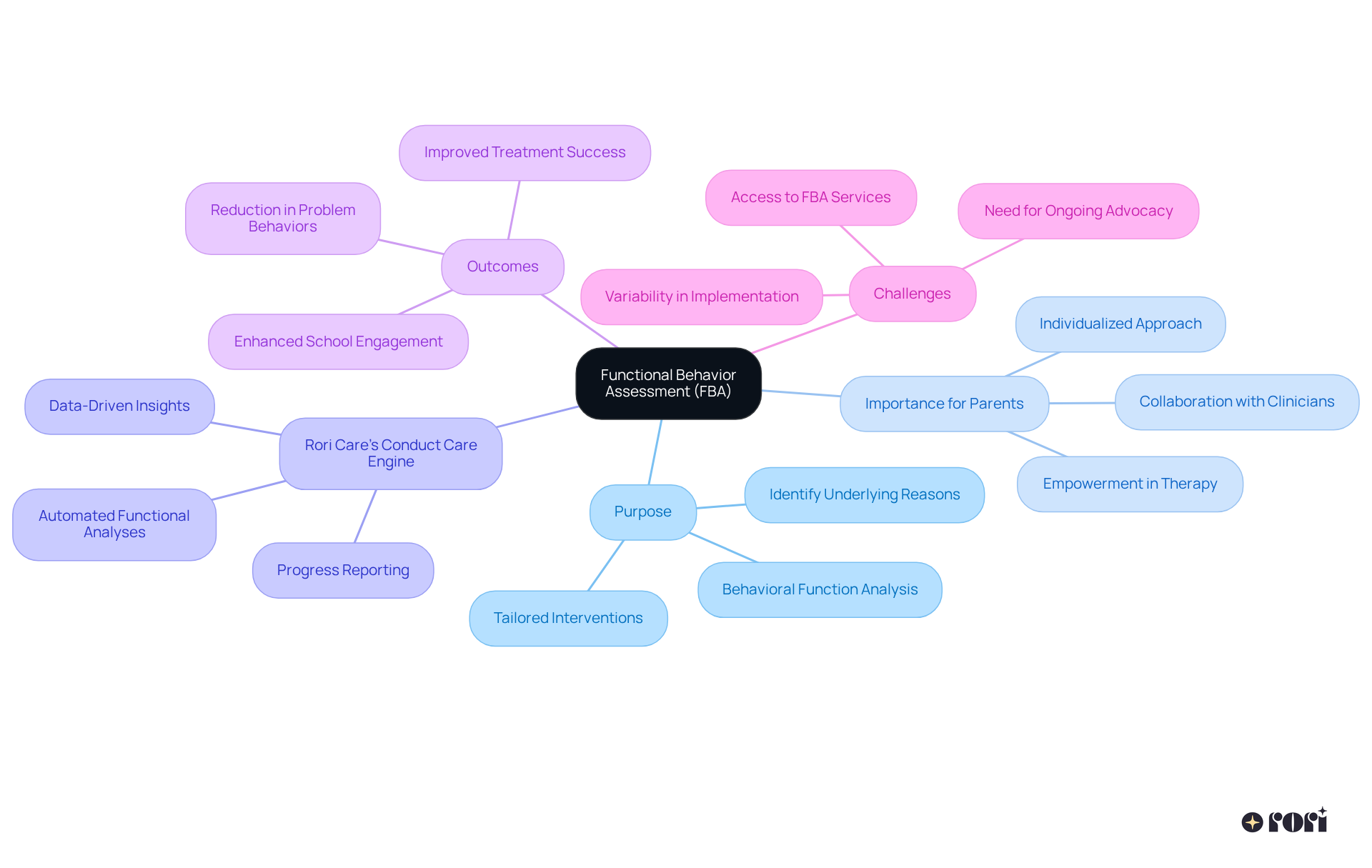
Generalization is all about taking what you've learned and using it in different places, with different people, and in various situations. For example, think about a young person who learns to greet friends during therapy. Wouldn't it be wonderful if they could also use that same greeting at school or home? This ability to transfer skills is super important in ABA acronyms therapy because it helps kids apply what they’ve learned in real life, rather than just in a therapy setting. Research shows that practicing greetings with different people and in various situations can really help kids adapt.
To encourage this kind of generalization, parents can inspire their children to practice skills in different environments, like during family outings or playdates. It's crucial to reinforce these skills outside of therapy sessions. For instance, if a child learns to ask for help in therapy, parents can create opportunities for them to use this skill in everyday situations, such as asking for assistance with a toy or schoolwork.
There are effective strategies to promote this transfer of skills. Using a variety of teaching materials and involving different caregivers or peers during sessions can make a big difference. At Rori Care, our care engine is always working to enhance treatment plans based on progress report data, making sure that interventions are tailored to each child's unique needs. This approach not only boosts communication and social skills but also helps children adjust their behaviors to fit different situations. As Yitz Diena wisely says, "This ability, known as generalization, which can be encapsulated by aba acronyms, is fundamental to ensuring that behavioral improvements translate into real-world success." By actively participating in their child's therapy and reinforcing these learned behaviors at home, parents can play a significant role in their child's ability to apply concepts, leading to better long-term outcomes in their development. Plus, maintaining these skills over time is key to ensuring they stay functional without needing constant reminders.
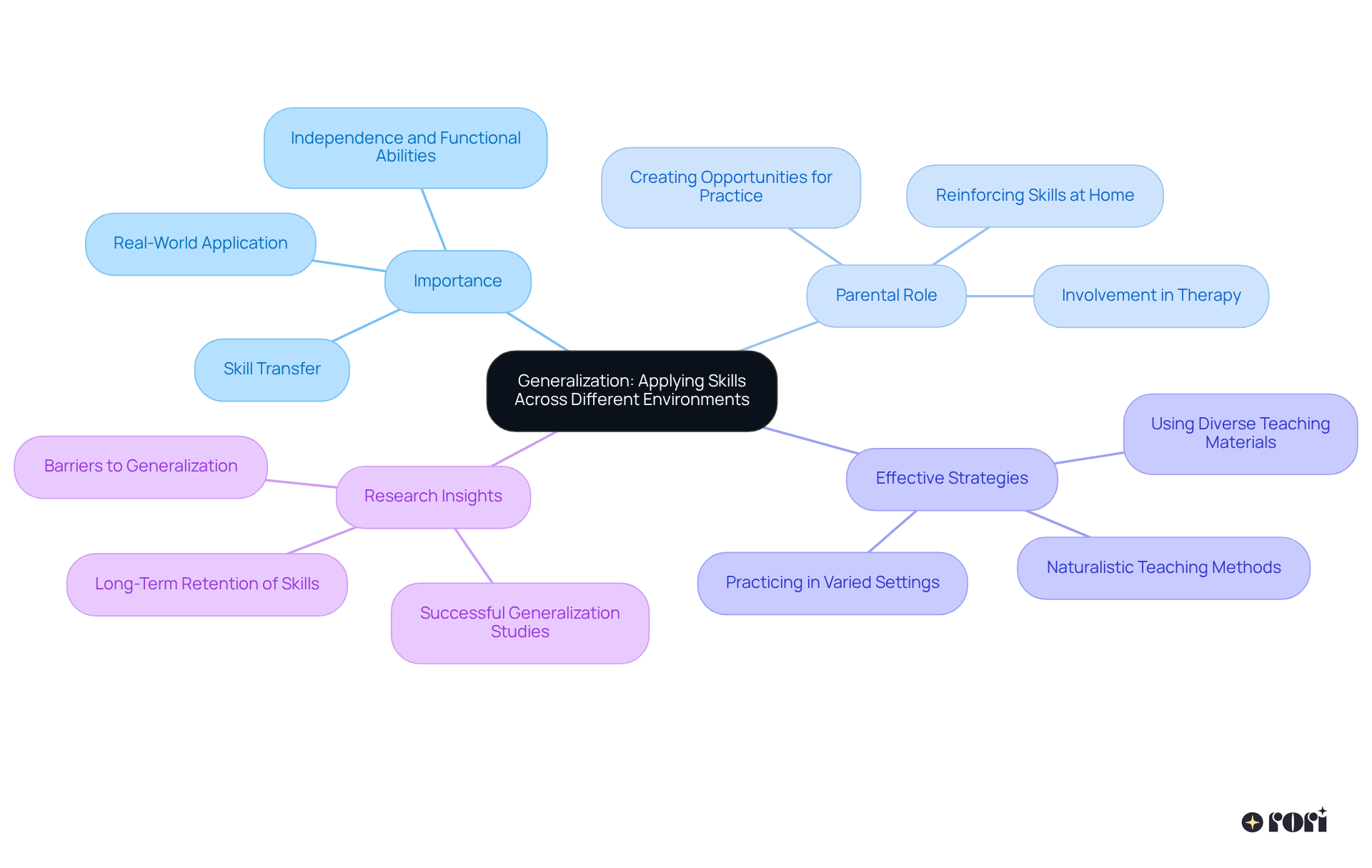
Understanding essential ABA acronyms is pivotal for parents navigating the complexities of Applied Behavior Analysis therapy. When you familiarize yourself with these terms, it not only enhances communication with professionals but also empowers you to actively participate in your child's therapeutic journey. By grasping the significance of acronyms like RBT, BCBA, FBA, and others, you can better support your child in achieving meaningful behavioral goals.
Throughout this article, we’ve highlighted key insights, including the roles of Registered Behavior Technicians and Board Certified Behavior Analysts in implementing effective interventions. We also emphasized the importance of teaching Activities of Daily Living (ADLs) and the concept of Generalization. These elements are crucial for fostering independence and improving the quality of life for children with autism. Plus, understanding the mechanics of reinforcement and functional behavior assessments gives you the tools needed to facilitate your child's progress.
Ultimately, the journey of understanding ABA acronyms is not just about learning terminology; it’s about fostering a collaborative environment that supports children in reaching their full potential. We encourage you to actively engage in your child's therapy, reinforcing learned behaviors at home and creating opportunities for practice in various settings. By doing so, you not only enhance your child's learning experience but also contribute significantly to their overall development and well-being. Embracing this knowledge is a vital step toward empowering both children and families in the transformative process of ABA therapy. Let’s explore this together!
What is Rori Care's approach to ABA therapy?
Rori Care's approach to ABA therapy combines technology with personalized care, ensuring that all Registered Behavior Technicians (RBTs) pass the board exam to confirm their mastery of the RBT Task List.
Why are ABA acronyms important for parents?
ABA acronyms are crucial for parents as they help in understanding their child's therapy, connecting with professionals, and actively supporting their child's behavioral goals through informed involvement and data collection.
What is Applied Behavior Analysis (ABA)?
Applied Behavior Analysis (ABA) is a scientific approach that utilizes evidence-based methods to enhance important behaviors, particularly communication and social skills, especially for children with autism.
How does ABA therapy improve communication skills in children?
ABA therapy leads to significant improvements in both verbal and non-verbal abilities through tailored interventions, helping children enjoy better social interactions by developing essential social skills like turn-taking and sharing.
What role do parents play in the success of ABA therapy?
Parents' involvement is crucial for the success of ABA therapy, as active engagement improves treatment outcomes and empowers caregivers to make informed decisions that positively influence their child's progress.
What is a BCBA and what qualifications do they need?
A BCBA, or Board Certified Behavior Analyst, is a credentialed professional who has completed educational and experiential requirements in behavior analysis, including a master's degree, supervised fieldwork hours, and passing the BCBA exam.
What are the responsibilities of a BCBA in autism therapy?
BCBAs conduct comprehensive evaluations, create customized treatment plans, and oversee Registered Behavior Technicians (RBTs) to ensure effective and tailored interventions for individuals with autism.
How do BCBAs enhance youth development results?
BCBAs enhance youth development results by using advanced tools for functional analysis, producing automatic progress reports, and continuously assessing and modifying treatment plans based on individual progress.
Why is the role of BCBAs becoming increasingly essential?
The role of BCBAs is becoming increasingly essential due to the growing demand for qualified professionals who can effectively improve the quality of life for children with autism through tailored interventions.